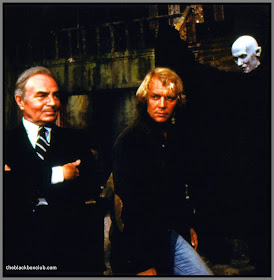Plot: Writer
Ben Mears returns to his hometown of Jerusalem’s Lot in Maine where he becomes
interested in writing a novel set around the sinister old mansion that
overlooks the town. The town is then struck by a series of killings where the
victims are left drained of blood. Ben and Straker, the mysterious owner of a
new antique store, become the immediate suspects, being the only strangers in
town. When the dead start returning from the grave to drink the blood of the
living, Ben and young monster movie fan Mark Petrie become the only ones
willing to believe that they are facing vampires. Together they set out to trap
and kill Barlow, the master vampire who inhabits the house on the hill.
Salem's Lot
(1975) was Stephen King’s second novel and this production was the second-ever
screen adaptation of King’s work, following Brian De Palma’s highly successful
version of Carrie (1976). For a time, Salem's Lot dallied about as to
whether it would be a theatrical film, with directorial names such as George A.
Romero, director of Night of the Living Dead (1968), and Larry Cohen, director
of It’s Alive (1974), associated with it. The 1979 vampire movie revival, which
also included the likes of the lavish Frank Langella remake of Dracula (1979),
Werner Herzog’s Nosferatu the Vampyre (1979) remake, the killer bat movie Nightwing
(1979), the disco film Nocturna: Dracula’s Granddaughter (1979), the
Dracula spoof Love at First Bite (1979) and the sex comedy Dracula Blows His
Cool (1979), proved the impetus to allow Salem's Lot to get off the
ground as a two-part TV mini-series. The directorial chair eventually went to
Tobe Hooper – Salem’s Lot was Hooper’s first Hollywood mainstream
production after the cult success of The Texas Chain Saw Massacre (1974).
Stephen King is equivocal about Salem's
Lot. That not withstanding, Salem's Lot is one of the most
underrated of Stephen King adaptations. Certainly, you can understand where
King is not too enthused as the mini-series makes a number of changes to the
book. It cuts several characters, compacts a couple into one. There are a
number of characters introduced and some of the plot strands are left
uncompleted. Bonnie Bedelia’s return as a vampire is peculiarly placed at the
end of the story, which ends up oddly unbalancing the climax. Most notable of
the changes is in the character of the vampire Barlow. The mini-series turns
him into a vampire clearly modeled on Max Shreck in Nosferatu (1922) and
eliminates all his dialogue – here he has a single line, whereas in the book he
has speeches that go on several pages explaining his origin. In fact, thanks to
James Mason’s magnetic performance, the central villain of the show emerges as
Straker, who is meant to be the vampire’s daytime aide, rather than Barlow – by
comparison try and imagine a version of Dracula (1897) where Renfield is
a more prominent character than Dracula.
Largely, Tobe Hooper prefers to not concern
himself so much with the adaptation but expands outward on it, staging it as a
series of set pieces. These set-pieces are intensely captivating – the
gravedigger trapped in the grave he is digging as the vampire child rises from
its coffin; Mark Kerwin watching in bed as Brad Savage eerily floats up in a
cloud of mist tapping at his window; a body rising from a morgue table and its
graphic dispatch with a crucifix made of wooden spatula; a gripping sequence
with David Soul and Mark Kerwin in a cellar struggling to stake Barlow’s body
as the sleeping brood of vampires wake up as the sun sets; and one gratuitous
but blackly funny sequence with George Dzundza returning to surprise his
adultering wife and her lover with a shotgun that entirely jolts one out of
their seat. Certainly, Salem's Lot’s failing is a tendency to be written
around these set-pieces – but what gripping set-pieces they are.
Everything else makes Salem's Lot a
class production. Heartthrob David Soul, then at the height of his popularity
with the TV series Starsky and Hutch (1975-9) is dull, but there is a
fine supporting cast with everybody else creating well-rounded characters,
especially the delightfully chirpy Bonnie Bedelia who makes a striking
transformation from schoolteacher to seductive vampire. The best of these is
James Mason, who appears to be having some of the best fun he had in his latter
years. Mason’s dry but melodious, deliberately absent-minded intonation lends
itself to a performance of startlingly calculated evil. Production designer
Mort Rabinowitz also delivers a memorable haunted house set.
Salem's Lot
is available in two forms. The most prevalent is the original 183 minute
mini-series, which is still seen in that format on video and cable revival
today, although is often cut by as much as 30 minutes running time. At the same
time, there was also a truncated feature-length 112-minute theatrical release
print that was shown in some countries.
Larry Cohen who, as mentioned above, was
originally pegged as director, made a loosely related sequel A Return to
Salem’s Lot (1987). The Stephen King novel was later remade as another two-part
mini-series ‘Salem’s Lot (2004), featuring Rob Lowe in the David Soul role,
Donald Sutherland as Straker and Rutger Hauer as Barlow. This is a different
version of the story than the 1979 version and, though the lesser, is not
uninteresting.
Edited and Design : Jamie Sumerville
Review: Richard Scheib

Edited and Design : Jamie Sumerville
Review: Richard Scheib

Join us at our FACEBOOK GROUP for DAILY POSTS and UPDATES :HERE










No comments:
Post a Comment
WE ENCOURAGE YOUR COMMENTS AND OPINIONS ABOUT OUR POSTS. FEEL FREE TO LEAVE A COMMENT.